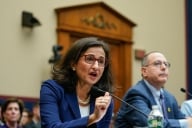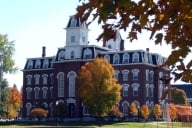You have /5 articles left.
Sign up for a free account or log in.
The market for nursing graduates remains hot, and plenty of students are vying for those open positions. Enrollment in entry-level baccalaureate nursing programs increased by nearly 8 percent in 2006 from the previous year, which marked the sixth straight year of gains. Community college programs are also seeing increases in applications and enrollments.
It's all positive news for the health care industry, which has suffered from a well-documented nursing shortage since the 1990s, when many hospitals cut their staffs and some colleges cut back their programs.
But for colleges of nursing, the increasing demand to accommodate more students presents a dilemma: Who will teach them?
When it comes to clinical nursing courses, college programs are bound to strict faculty-to-student ratios, set by individual states. One instructor to every 10 or 12 students is a fairly common ratio. So even as administrators and state lawmakers seek more slots for students, there's a ceiling on expansion unless more faculty are recruited or produced.
That's not happening quickly. A survey released last year by the American Association of Colleges of Nursing identified at least 637 faculty vacancies at more than 300 nursing schools with baccalaureate or graduate programs -- or what amounts to a nearly 8 percent faculty vacancy rate. The majority of the openings are tenure-track positions that require applicants have a doctorate, the survey shows.
Meanwhile, there continues to be a backlog of students. In 2006, more than 38,000 nursing school candidates deemed "qualified" by the AACN were turned away from entry-level baccalaureate programs, while a total of 50,783 nursing school applicants enrolled and registered in courses. When the new students are added to the pool of all students enrolled, total enrollment rises to 133,578.
Nearly three quarters of the colleges that responded to the AACN survey pointed to faculty shortages as a reason for not accepting the applicants. Community colleges are turning away 3.3 "qualified" applicants for every one turned away by four-year institutions, said Roxanne Fulcher, director of health professions policy at the American Association of Community Colleges.
At many nursing schools, wait lists are shrinking after years of growth, officials say, not because slots are opening up, but because students are becoming frustrated that their chances of enrolling are dim.
Some see a troubling pattern forming. Hospitals and medical offices make offers that top graduates can't refuse. Students choose immediate employment over continuing their nursing educations. The pool of candidates who can become nursing faculty members diminishes and the profession eventually suffers.
"Faculty shortage is the biggest problem we have," said Geraldine "Polly" Bednash, executive director of AACN. "Most of the focus is on producing people at the bottom of the pipeline, but we aren't looking out for the future."
Incentives to Teach
A major issue is pay. Data continue to reflect a longstanding trend -- those who stay in academe are compensated worse than their counterparts with the same level of education who enter the practice.
Six-figure salaries aren't uncommon for nursing graduates with doctoral degrees who work as top-level managers, Bednash said. That's not the case for those who teach. In 2006, the average salary for a full-time nursing faculty member across all ranks was $88,476 for those with doctorates and $64,011 for those with master's degrees, according to the AACN.
It's particularly difficult to persuade graduates to choose teaching, many say, because they are likely to be supporting a family and reliant on immediate financial payoffs. (Subsequently, an increasing number of international faculty have been brought to teach in recent years.)
To begin with, there's a fairly small pool of potential faculty. Roughly 13 percent of registered nurses have an MSN or doctoral degree, according to the National Organization for Associate Degree Nursing. Only a fraction of associate degree students ever go on to receiving higher degrees, Bednash said.
And part of the growing concern is that nursing faculty members -- on average in their late 50s -- are set to retire in droves. Since nursing students at all levels are often in their 30s or 40s by the time they graduate, their teaching years are limited.
That's why community college and nursing groups are calling for an increase in RN to MSN programs as a way for colleges to groom teachers who start at an earlier age. These programs give students who have an associate degree a quicker path to earn their master's degree at a given institution.
Fulcher, of AACC, said there are roughly 150 of these programs across the country. Alisa Schneider, 43, completed an RN to MSN program at George Mason University before accepting a nursing faculty job at Portland Community College.
Schneider had worked for 15 years, primarily in pediatrics, after receiving her associate degree. But she was feeling trapped. The program allowed her to work part-time for most of the three-plus years it took to finish.
"It saved my career," she said. "But I don't see it as being a quick-fix answer for getting more educators. You need to have some work experience first. I see this as a program that helps rejuvenate careers and gets people to move into the higher ed arena."
In response to the faculty shortage, a number of incentive programs are underway:
- The AACN and the California Endowment, a private, statewide health foundation, launched last year a new scholarship and mentorship program to increase the number of minority nursing faculty in California. Nursing students from underrepresented backgrounds are eligible to receive up to $18,000 in funding support to complete a graduate nursing degree. In exchange, students are asked to commit to teaching in a California nursing school after graduation.
- Colorado's state legislature passed two nurse faculty shortage bills last year that aimed to address the salary differential for working nurses and those in academe. The Nursing Teacher Loan Forgiveness Program is designed to provide up to $20,000 in loan forgiveness for students pursuing master's or doctoral degrees in exchange for a five-year teaching commitment at a Colorado school of nursing. The Nursing Faculty Fellowship Program is intended to help nursing schools in filling faculty vacancies by giving fellowship payments of up to $10,000 a year for three years.
Patricia Moritz, dean of the School of Nursing at the University of Colorado at Denver and Health Sciences Center, said while the bills are "very well-intentioned," there are major limitations. For instance, she said the way the regulations of the forgiveness program were written isn't consistent with the way teaching positions are set up. Faculty are asked to teach in the classroom for 40 hours a week to be eligible for the program, she said, which makes it "virtually impossible" for them to apply.
Patsy Maloney, director of professional development and continuing studies and an associate professor at the Pacific Lutheran University School of Nursing, says a problem with federal loan forgiveness programs is that a faculty member must stay at one institution, even though there might not be a full-time position there.
Dealing with Supply and Demand
New nursing programs are sprouting across the country. Among them, Miami Dade College is starting a bachelor's of science program in nursing. Western Governors University is starting two new master’s programs in nursing: one to train nurses to manage teams of nurses and one for those who will be involved in nursing education. Goshen College, in Indiana, is starting a master’s degree in nursing.
At Portland Community College, where Schneider teaches, 716 "qualified" applicants vied for 100 openings last year, according to Claudia Michel, director of the nursing program. The college uses a lottery system to determine which students are admitted and also selects 25 alternates to account for those who might drop out or enroll elsewhere.
But at a time when avoiding dropouts is crucial, many schools are avoiding random selection and looking at factors such as grade point average and work experience.
“Some schools can justify putting aside access to all in a time of great demand,” Fulcher, of AACC, said.
At Delaware Technical and Community College, admissions has always been merit-based, says Jerry McNesby, vice president for finance. To help with retention, the college has added a program that helps students prepare for tests and assignments. McNesby said the college has yet to measure whether retention has improved.
Five years ago, for every student admitted to the Delaware program there were 2.5 who were turned away. The state has helped decrease the waiting list by making use of proceeds from a tobacco settlement to fund an expansion of the nursing program in three counties. This program has grown to 814 students from 354, and more than 40 instructors were hired on top of 56 already teaching in the program.
Moritz, the Colorado dean, said her program "can't go any higher" until it gets more faculty and state funding. The school has 1,000 applicants for 230 slots each year. There is no wait list, she said, because it does a disservice to students.
"We know there's a shortage locally and nationally of nurses, but hospitals have limited slots open for new graduates," she said, adding that the majority of vacancies are filled by more advanced nurses.
For that reason, Colorado staggers its start date for new students so that all of them aren't released into the job market at the same time. (That way, the program also can accommodate students into the teaching clinics.)
Bednash, of AACN, points out that while enrollments are increasing nationwide, the rate of increase has slown for the past several years.
"I suspect it's not going to be long before we see a flat line in enrollment," she said. "There's a clog, and faculty are the Drano."








